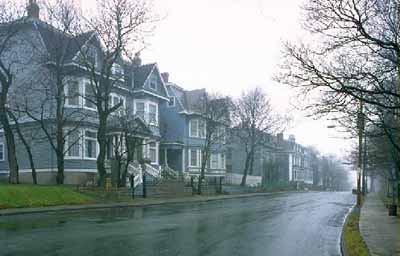Rennie's Mill Road Historic District National Historic Site of Canada
St. John's, Newfoundland and Labrador

General view
© Parks Canada Agency / Agence Parcs Canada, 1993
Address :
21-79,12-54 Rennie's Mill Road, St. John's, Newfoundland and Labrador
Recognition Statute:
Historic Sites and Monuments Act (R.S.C., 1985, c. H-4)
Designation Date:
1987-11-20
Dates:
-
1846 to 1920
(Construction)
-
1880 to 1905
(Significant)
Event, Person, Organization:
-
Margaret Duley
(Person)
-
F.W. Alderdice
(Person)
-
Edward Patrick Morris
(Person)
-
Sir Richard Squires
(Person)
-
J.G. Herder
(Person)
-
Sir Marmaduke Winter
(Person)
-
Dr. Cluny MacPherson
(Person)
-
John Southcott
(Architect)
-
John Thomas Southcott
(Architect)
-
William Frederick Butler
(Architect)
Other Name(s):
-
Rennie's Mill Road Historic District
(Designation Name)
Research Report Number:
1987-008, 1986-036, 2005-SDC/CDE-005
Plaque(s)
Existing plaque: Bannerman Park, St. John's, Newfoundland and Labrador
In the aftermath of the city's Great Fire of 1846, Rennie's Mill Road was developed as a residential area where the prosperous residents sought tranquil and safe accommodations away from the crowded downtown core. It contains a remarkably harmonious and homogeneous grouping of large, wooden homes that are closely associated with individuals prominent in the political, financial and social life of Newfoundland, among them four prime ministers of the colony. Built in the latter part of the 19th century, a substantial number of these houses were designed in the Second Empire style, which, with its steep mansard roofs, is one of the most characteristic residential forms in St. John's. Another popular style represented is the Queen Anne Revival, which is similar in scale but more varied in form. This district is a rare intact 19th century example of the planning phenomenon: the residential suburb.
Description of Historic Place
Rennie’s Mill Road Historic District National Historic Site of Canada is an upper middle-class residential suburb located just beyond the centre of St. John’s, Newfoundland. Comprised of a harmonious group of large, wooden houses from the late 19th to the early 20th centuries, whose owners were for the most part prominent Newfoundlanders, it includes fine examples of Second Empire and Queen Anne Revival-style domestic architecture, set on well-treed lots. The designation refers to the area defined by Rennie’s Mill Road from Military Road running north one block to its termination at Circular and includes all the properties on the road (buildings on the west side numbers 21 to 79 and on the east side numbers 12 to 54 and the open spaces around them), extending to their rear property lines.
Heritage Value
Rennie’s Mill Road Historic District was designated a national historic site of Canada because: it is a remarkably harmonious and homogeneous grouping of upper middle class residences dating from the late 19th and early 20th centuries that are, for the most part, closely associated with individuals prominent in the political, financial and social life of Newfoundland in that period.
Built after the Great Fire of 1846, Rennie’s Mill Road Historic District was a safe and tranquil retreat from downtown St. John’s. The heritage value of the district resides in it association with prominent Newfoundlanders and in the physical illustration of a prosperous, stylish suburb of the late 19th and early 20th centuries.
Source: Historic Sites and Monuments Board of Canada, Minutes, November 1987.
Character-Defining Elements
Key elements contributing to the heritage value of this site include: the continuity of the streetscape without any major gaps; the spacious and well-treed lots; the consistent scale of the buildings and lot sizes; the generally consistent set-back of houses from the street; the mixture of single and double houses; the predominance of wooden architecture; the presence along the front of many lots of low stone walls or wrought iron fences; the square massing, hipped roof, and classically-inspired design and detailing of the mid-19th century houses, including numbers 36 to 38, 63 and 69; the late 19th-century Second Empire-style houses, with their pavilion massing, steeply pitched mansard roofs, and classically-inspired detailing; the Second Empire houses designed by J.T. Southcott, with their bellcast mansard roofs, round-headed dormers, bay windows on the front facade, side entranceway, fine detailing and interior ground floor hallway running parallel to the main facade; Park Place, a quadruple residence with a double house flanked by single houses in the Southcott variant of Second Empire style; the Second-Empire-style residence at number 49 with its brick construction material, stone trim, and central entrance; the Queen Anne Revival-style houses with their rectangular massing enlivened by projecting bays, wings, and towers, high, varied roof lines, deep cornices, fine detailing, clapboard or shingle sheathing, porches, balconies and variety of window types; the heritage value of the Queen Anne Revival-style Winterholme National Historic Site of Canada.